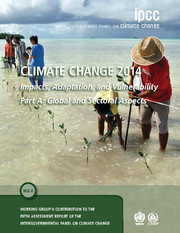 Climate Change 2014 – Impacts, Adaptation and Vulnerability: Part A: Global and Sectoral Aspects
Climate Change 2014 – Impacts, Adaptation and Vulnerability: Part A: Global and Sectoral Aspects Book contents
- Frontmatter
- Contents
- Foreword, Preface, and Dedication
- Summary for Policymakers
- Technical Summary
- Cross-Chapter Boxes
- Chapters 1-20
- Chapter 1 Point of Departure
- Chapter 2 Foundations for Decision Making
- Chapter 3 Freshwater Resources
- Chapter 4 Terrestrial and Inland Water Systems
- Chapter 5 Coastal Systems and Low-Lying Areas
- Chapter 6 Ocean Systems
- Chapter 7 Food Security and Food Production Systems
- Chapter 8 Urban Areas
- Chapter 9 Rural Areas
- Chapter 10 Key Economic Sectors and Services
- Chapter 11 Human Health: Impacts, Adaptation, and Co-Benefits
- Chapter 12 Human Security
- Chapter 13 Livelihoods and Poverty
- Chapter 14 Adaptation Needs and Options
- Chapter 15 Adaptation Planning and Implementation
- Chapter 16 Adaptation Opportunities, Constraints, and Limits
- Chapter 17 Economics of Adaptation
- Chapter 18 Detection and Attribution of Observed Impacts
- Chapter 19 Emergent Risks and Key Vulnerabilities
Chapter 20 - Climate-Resilient Pathways: Adaptation, Mitigation, and Sustainable Development
Published online by Cambridge University Press: 05 January 2015
- Frontmatter
- Contents
- Foreword, Preface, and Dedication
- Summary for Policymakers
- Technical Summary
- Cross-Chapter Boxes
- Chapters 1-20
- Chapter 1 Point of Departure
- Chapter 2 Foundations for Decision Making
- Chapter 3 Freshwater Resources
- Chapter 4 Terrestrial and Inland Water Systems
- Chapter 5 Coastal Systems and Low-Lying Areas
- Chapter 6 Ocean Systems
- Chapter 7 Food Security and Food Production Systems
- Chapter 8 Urban Areas
- Chapter 9 Rural Areas
- Chapter 10 Key Economic Sectors and Services
- Chapter 11 Human Health: Impacts, Adaptation, and Co-Benefits
- Chapter 12 Human Security
- Chapter 13 Livelihoods and Poverty
- Chapter 14 Adaptation Needs and Options
- Chapter 15 Adaptation Planning and Implementation
- Chapter 16 Adaptation Opportunities, Constraints, and Limits
- Chapter 17 Economics of Adaptation
- Chapter 18 Detection and Attribution of Observed Impacts
- Chapter 19 Emergent Risks and Key Vulnerabilities
Summary
20.1. Introduction
Following summaries of what we know about climate change impacts, vulnerabilities, and prospects for adaptation (Chapter 18) and reasons for concern (Chapter 19), this chapter summarizes what is currently known about options regarding what to do in responding to these risks and concerns.
In terms of “what to do” to address climate change and threats to development now and in the future, the chapter identifies and discusses climate-resilient pathways. Climate-resilient pathways are defined in this chapter as development trajectories that combine adaptation and mitigation with effective institutions to realize the goal of sustainable development. They are seen as iterative, continually evolving processes for managing change within complex socio-ecological systems; taking necessary steps to reduce vulnerabilities to climate change impacts in the context of development needs and resources, building capacity to increase the options available for vulnerability reduction and coping with unexpected threats; monitoring the effectiveness of vulnerability reduction efforts; and revising risk reduction responses on the basis of continuous learning. As such, climate-resilient pathways include two main categories of responses:
• Actions to reduce human-induced climate change and its impacts, including both mitigation and adaptation toward achieving sustainable development
• Actions to ensure that effective institutions, strategies, and choices for risk management will be identified, implemented, and sustained as an integrated part of achieving sustainable development.
In many cases, each of the two categories of responses has the potential to benefit the other as well, offering potentials for win-win kinds of integration, although mechanisms and institutions are needed to address cases where the two elements have negative effects on each other and to ensure that positive synergies are realized. Because climate change challenges are significant for many areas, systems, and populations, climate-resilient pathways will generally require transformations—beyond incremental approaches—in order to ensure sustainable development (see Sections 20.2.3.1, 20.6.2; for related language employed by the UNFCCC, see Box 20-1).
- Type
- Chapter
- Information
- Climate Change 2014 – Impacts, Adaptation and Vulnerability: Part A: Global and Sectoral AspectsWorking Group II Contribution to the IPCC Fifth Assessment Report, pp. 1101 - 1131Publisher: Cambridge University PressPrint publication year: 2014
- 25
- Cited by
